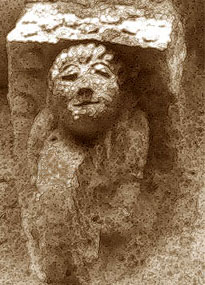![]()
|
Outside  Nowadays, the church warm aspect must not conceal its original function of strengthened refuge. The North side shows no opening, except a window added several centuries later. Narrow portals are open in West and South walls, with massive oak door leaves. The South door could be strengthened by a wooden bar sliding into the wall. Some loopholes complete the defense. The bell tower shows important openings only at discouraging height ... Vaults and roof being of stone are fireproof. For the famous dry stone roof, the material of wich, according to regional custom is named, "platins" or "lauzes", refer to the leaflet published in 1997 by the "Ministère de la Culture", available locally in the nearby Museum. However, this mode of roofing, economical in the construction (the local stone material being cheap ) may in use appear to be poorly effective against infiltrations and therefore involve expensive maintenance. The roof is heavy: 4m² of stones cover only 1m². There are less than ten churches covered with stones in Poitou-Charente, while dry stone roofing is always in use 200 km southward, in the Dordogne. As for many Romanesques buildings, the wall decoration is freer on the outside than inside. Corbels showing human or animals heads, nail heads an star shaped rosettes decorate the circumference of the apse. The South wall the and the bell tower show some "grotesque" bas-reliefs, only visible with binoculars.
|